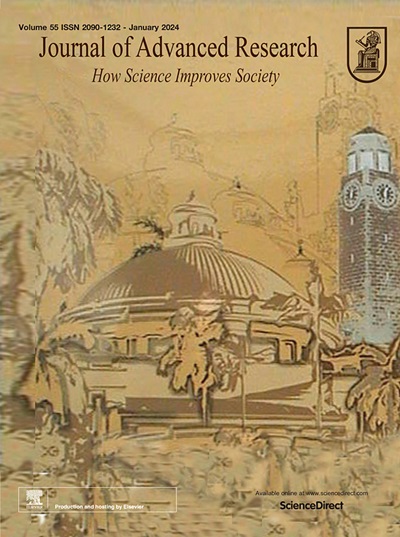带电聚苯乙烯微塑料抑制了水培白菜系统对 14C 三氯生的吸收和转化。
IF 13
1区 综合性期刊
Q1 MULTIDISCIPLINARY SCIENCES
引用次数: 0
摘要
导言:自 COVID-19 事件爆发以来,药品和个人护理产品(PPCPs)中的微塑料(MPs)和三氯生的含量明显上升。微塑料和三氯生同时存在于环境中,但它们之间的相互作用以及随后对三氯生在植物中的归宿产生的影响还不甚了解:方法:采用 14C 标记法和液相色谱-四极杆/飞行时间质谱(LC-QTOF-MS)分析法,阐明三氯生在水培-卷心菜系统中的生物累积、分布和代谢情况。通过激光共聚焦扫描显微镜和扫描电子显微镜研究了带不同电荷的 PS-MPs 在卷心菜中的分布:结果表明,MPs 对三氯生在水培-卷心菜系统中的生物累积和代谢有显著影响。与非 MP 处理(对照组)相比,PS-COO-、PS 和 PS-NH3+ MPs 分别降低了三氯生在卷心菜中的生物累积率 69.1%、81.5% 和 87.7%。PS-MPs 还能减少三氯生在卷心菜中从根部向嫩芽的转移,PS-COO-、PS 和 PS-NH3+ 的减少率分别为 15.6%、28.3% 和 65.8%。此外,PS-NH3+ 还能显著抑制水培白菜系统中三氯生的磺化、硝化和亚硝化等代谢途径。上述发现可能与 PS-NH3+ 和三氯生之间的强吸附性有关,PS-NH3+ 也可能抑制卷心菜的生长。特别是,PS-NH3+ 上吸附的三氯生明显多于 PS 和 PS-COO-。与对照组相比,PS-NH3+ 组的卷心菜生物量减少了 76.9%:结论:带电 PS-MPs,特别是 PS-NH3+ 能明显抑制水培白菜系统对三氯生的吸收和转化。这为三氯生和其他与微塑料共存的多氯联苯农药的归宿提供了新的视角,有助于进行潜在的风险评估。本文章由计算机程序翻译,如有差异,请以英文原文为准。

Charged polystyrene microplastics inhibit uptake and transformation of 14C-triclosan in hydroponics-cabbage system
Introduction
Since the outbreak of COVID-19, microplastics (MPs) and triclosan in pharmaceuticals and personal care products (PPCPs) are markedly rising. MPs and triclosan are co-present in the environment, but their interactions and subsequent implications on the fate of triclosan in plants are not well understood.
Objective
This study aimed to investigate effects of charged polystyrene microplastics (PS-MPs) on the fate of triclosan in cabbage plants under a hydroponic system.
Methods
14C-labeling method and liquid chromatography coupled with quadrupole/time-of-flight mass spectrometry (LC-QTOF-MS) analysis were applied to clarify the bioaccumulation, distribution, and metabolism of triclosan in hydroponics-cabbage system. The distribution of differentially charged PS-MPs in cabbage was investigated by confocal laser scanning microscopy and scanning electron microscopy.
Results
The results showed that MPs had a significant impact on bioaccumulation and metabolism of triclosan in hydroponics-cabbage system. PS-COO-, PS, and PS-NH3+ MPs decreased the bioaccumulation of triclosan in cabbage by 69.1 %, 81.5 %, and 87.7 %, respectively, in comparison with the non-MP treatment (control). PS-MPs also reduced the translocation of triclosan from the roots to the shoots in cabbage, with a reduction rate of 15.6 %, 28.3 %, and 65.8 % for PS-COO-, PS, and PS-NH3+, respectively. In addition, PS-NH3+ profoundly inhibited the triclosan metabolism pathways such as sulfonation, nitration, and nitrosation in the hydroponics-cabbage system. The above findings might be linked to strong adsorption between PS-NH3+ and triclosan, and PS-NH3+ may also potentially inhibit the growth of cabbage. Specially, the amount of triclosan adsorbed on PS-NH3+ was significantly greater than that on PS and PS-COO-. The cabbage biomass was reduced by 76.9 % in PS-NH3+ groups, in comparison with the control.
Conclusion
The uptake and transformation of triclosan in hydroponics-cabbage system were significantly inhibited by charged PS-MPs, especially PS-NH3+. This provides new insights into the fate of triclosan and other PPCPs coexisted with microplastics for potential risk assessments.
求助全文
通过发布文献求助,成功后即可免费获取论文全文。
去求助
来源期刊

Journal of Advanced Research
Multidisciplinary-Multidisciplinary
CiteScore
21.60
自引率
0.90%
发文量
280
审稿时长
12 weeks
期刊介绍:
Journal of Advanced Research (J. Adv. Res.) is an applied/natural sciences, peer-reviewed journal that focuses on interdisciplinary research. The journal aims to contribute to applied research and knowledge worldwide through the publication of original and high-quality research articles in the fields of Medicine, Pharmaceutical Sciences, Dentistry, Physical Therapy, Veterinary Medicine, and Basic and Biological Sciences.
The following abstracting and indexing services cover the Journal of Advanced Research: PubMed/Medline, Essential Science Indicators, Web of Science, Scopus, PubMed Central, PubMed, Science Citation Index Expanded, Directory of Open Access Journals (DOAJ), and INSPEC.
 求助内容:
求助内容: 应助结果提醒方式:
应助结果提醒方式:


